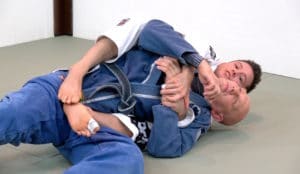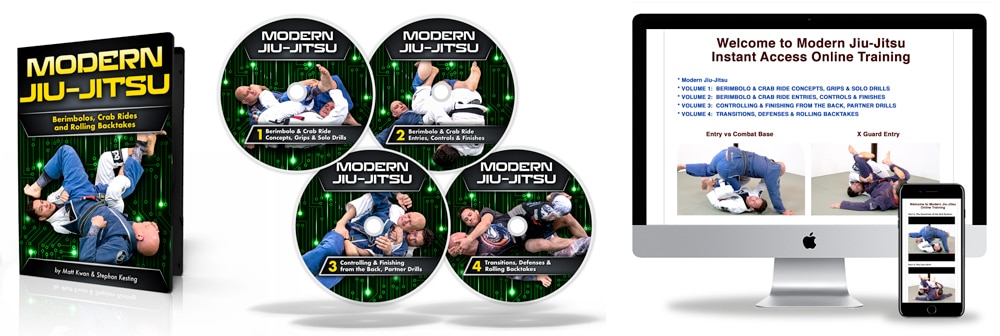The leg drag is a modern addition to the world of guard passing in BJJ. It was popularized by world class competitors like the Mendes Brothers among many others.
And if you spend even a little bit of time competing or watching major tournaments you will notice this style of pass being used successfully in every weight division, from white belt up to world champion black belt.
Not only is this guard pass an incredibly powerful pass in it’s own right, but it sets up tons of other passes, back takes, and submissions.
Even if you don’t incorporate it into your game you need to be familiar with it because someone will surely try and use it on you! And by learning how to do this pass yourself you’ll automatically develop a better understanding of how to shut it down when you’re on the bottom.
How to do the Leg Drag (Video)
In this video Rory Van Vliet shows you exactly how to do the leg drag pass. He breaks down the key details and points of control that make this form of redirection pass easy to understand and use.
Check it out below!
Leg Drag Step 1, Initiating the Pass
The Leg Drag is such a great pass to add to your game, because it’s a long range style of pass that you can use early on against your opponent without having to close as much distance or deal with as many layers of their guard.
It can be set up at long distance, such as when you’re initially just coming into contact with the open guard.

Approaching the open guard
As you get closer to your opponent you’ll have to use other passes, like the double under, knee cut, and the over-under.
For the closer range guard passes the battle to control the knee and hip to make the over under pass work can be a challenge and requires mistakes to be made on your opponents’ part.

The over-under pass, an example of a close range guard pass
The Leg Drag doesn’t require quite the same level of commitment because it is usable at the furthest range of your opponents’ guard (the end of their feet instead of their shins or knees).
As long as you are able to form grips on the pant cuffs of your opponents Gi (indirect control), or around their ankles (direct control), you have an opportunity to use this pass, making it a very useful first pass even if your goal is to just make your opponent react so that you can move into a closer range of pass.

Controlling the pant cuffs for the leg drag pass

Controlling the ankles for the leg drag pass
As you get comfortable with this pass you will find it creates a lot of opportunities!
Leg Drag Step 2, Redirection of the Legs
The Leg Drag Pass is a form of redirection pass, what does this mean?
It means that this style of pass relies on you creating a small response from your opponent by applying pressure to their feet or moving them to one side as you move so that they must react by following your movement.
This creates an opportunity for you to redirect their legs past your hips so that their most powerful body parts (their hips and legs) are no longer facing you.

Redirecting the legs past your body
By using your C-Clamp style grips on their ankles (as shown above) you will have two frames in place that check your opponents ability to reposition their legs and hips, making it hard for them to retain their guard as you move further into the Leg Drag Pass.
It’s important that you maintain points of control (a placeholder system of grips and frames) as you advance forward so that your opponent has limited space to move at every point of your attack.
This makes any movement they can do much easier to follow, predict, and beat.

Using the placeholder system to maintain control
Once you’ve redirected your opponent’s legs and hips, you’re ready to move into your next position of control.
This makes it difficult (if not impossible) for your opponent to move their hips and retain their guard by facing you. You will do this by maintaining your earlier C-Clamp grips until you’ve replaced them with another form of control.
You will advance your control from the earlier C-Clamp grips by pinning your opponents bottom leg with pressure from your shin and knee, and for the upper leg it will become the closing of your armpit below their knee and anchoring your grip on their hip or belt.
Why is this control so important?

If you release all points of control then…

…your opponent will recover his guard.
If you leave too much space, or don’t maintain your points of control before moving further into the pass, it would be a very easy movement for your opponent to recompose his guard by turning his left knee down and in, or by high-legging his right back onto your hips or shoulders.
You want to limit your opponent’s ability to make space so that they can’t make easy retention movements.
Leg Drag Step 3: Consolidating the Pass

Dropping your weight in the leg drag pass
Once you’ve successfully chambered your opponents left leg in you armpit (while using the placeholder system mentioned before) you’re now ready to drop your knee into his right leg to effectively pin his hips in the wrong direction so you can begin to finish the leg drag pass (as depicted below).

Pinning the hips with your knee and shin over his bottom leg
It’s critical that you keep your chambering elbow closed so that it can’t be used by your opponent as a lever to create space and disrupt your base by opening the structure of your upper body.
Once you have reached this range of the Leg Drag Pass it’s basically guaranteed, meaning that this position forms a kind of hub that creates all manner of opportunities depending on the grips you use and the reactions your opponent gives you.
The result is a variety of ways to consolidate side control, take the back, or begin moving into submission controls (as you get comfortable here you will find different opportunities that suit you).
Leg Drag Step 4: Following Up After the Pass
You have successfully passed your opponents guard, so what next?
The beautiful thing about the Leg Drag Pass is that it forces your opponent to face away from you, which then gives you a chance to get to their back, the king of positions.
We left off the previous step here, where you’ve forced your opponent onto his side and exposed his back.

Opponent on side with his back exposed
This pass creates a strong opportunity for the back take, and one of the easiest ways for you to do that is with the Chair Sit.
Here’s a video I shot with Rob Biernacki in The BJJ Formula about how to use the Chair Sit to take the back…
In the chair site you’ll first use a strong seatbelt and shoulder pressure to force your opponent to turn almost belly down, allowing you to step across their hip and chamber your elbow (the choking hand) against your own thigh.

Chair sit part 1: use shoulder pressure to turn your opponent and step over his body
Why?
So that you can sit backwards and roll your opponent over your bottom leg and get the second hook to take the back.

Chair sit part 2: sit backwards and pull him towards you to create space for your second (bottom) hook
As you become more competent with the Leg Drag you may want to try and add in more advanced movements.
A great example of this is combining the Leg Drag with the Crab Ride back take (covered in detail by Matt Kwan in the Modern Jiu-jitsu Instructional)…
To transition from the Leg Drag to the Crab Ride Matt Kwan initially takes a more extreme angle in the Leg Drag position (i.e. his body is almost 90 degrees to my own, overhooks my leg, and remains lower on my hip.

Setting up the Crab Ride from the Leg Drag
After he rolls he uses a variety of frames and hooks to lift his opponent (me) so that he can make a hook on my opposite leg and take the back.

Crab Ride frames and hooks while working towards the back

Achieving Back Control after the Crab Ride
There are a TON of ways to take the back and/or transition into submissions from the Leg Drag – the two examples above are just the tip of the iceberg.
The bottom line is that anytime you get past your opponent’s legs and make him turn away from you then good things are going to happen.
Good luck with the Leg Drag – it’s a technique well worth developing!
More Resources
Most of the breakdown of the Leg Drag pass in this article comes from a single video in The Guard Retention Formula.
It may seem a bit strange that an instructional about how STOP people from passing your guard would also cover how to pass the guard, but the truth is that in order to have good guard defense you also need to understand the guard passes themselves.
By knowing what your opponent is up to you can then take the necessary steps to shut him down.
In The Guard Retention Formula, one of the newest instructionals from Grapplearts, Rory Van Vliet and I show you how to systematically shut down and counter all the most powerful and most popular guard passes your opponents will use to try and pass your guard.
The Guard Retention Formula is available in DVD, online streaming and mobile app format.
Check it out because it could absolutely change your game for the better!
Also if you’re struggling with how to build a coherent gameplan in BJJ you may find The Strenuous Life Podcast episode on BJJ Game Plan Development to be helpful.
And finally if you’re looking to further your offensive skills to compliment your new defensive ones, then here are some great resources: The BJJ Formula with Rob Biernacki, and Modern Jiu-Jitsu with Matt Kwan.
The post How to Do the Leg Drag Guard Pass appeared first on Grapplearts.



